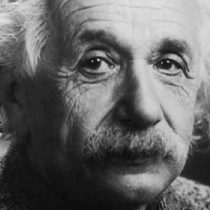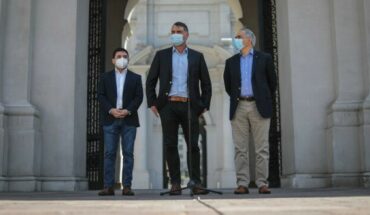
His affliction came from a terrible event that had occurred almost 10 years earlier, a massacre that is still unmatched and for which he felt partly responsible.
On August 6 and 9, 1945, the United States dropped two atomic bombs on Hiroshima and Nagasaki, in Japan.
Interactive special: how was the “hell” in which tens of thousands died from the atomic bombs of Hiroshima and Nagasaki
The most conservative estimates estimate that by December 1945 some 110,000 people had died in both cities, from the explosion and radiation.
Other studies claim that it could actually be more than 210,000.
How was the first atomic bomb trial 75 years ago (and how the world changed)
Since then, no other country has dared to carry out a nuclear attack.
“Perhaps you can forgive me,” Einstein said, as his friend Linus Pauling wrote in a letter, then Nobel Prize in Chemistry and then Nobel Peace Prize in 1962.
The reasons why Einstein is associated – who was considered a “convinced pacifist” – with the atomic bomb are basically two: one scientific and one political.
On the one hand, its famous formula E-mc2 is one of the principles for its operation.
The other reason is that in 1939 Einstein sent a letter to then-President of the United States, Franklin Delano Roosevelt, who pushed the idea of an atomic bomb at the government level.
The story, however, is more complex and, according to experts, Einstein gets better off than he thought.
On August 6, 1945, the United States dropped the atomic bomb on Hiroshima
“He contributed, but he did not play such an important role in the development of the bomb,” Alex Wellerstein, a historian specializing in nuclear weapons, tells BBC World.
“It’s not as important as people think,” Wellerstein adds.
E-mc2
In 1905, 40 years before the bombs, Einstein published what is now considered one of the most famous formulas in history: E-mc2.
In essence, the formula states that the energy (E) is equal to its mass (m) multiplied by the speed of light squared (c2).
Einstein’s “miracle year” in which he wrote 5 scientific studies that revolutionized physics
That means that a small amount of mass equals immense amounts of energy.
That principle explains, for example, why only a few kilos of uranium and plutonium used in atomic bombs were sufficient to create an explosion with energy equivalent to more than 15,000 tons of TNT in the case of Hiroshima, and 21,000 tons of TNT in Nagasaki.
Time magazine referred to Einstein as “the father of the bomb”
The relationship between the equation and the bomb seems so direct that, in July 1946, the magazine Time published on cover an illustration of Einstein’s face, and in the background, the mushroom-shaped cloud that produced the explosions.
In the middle of the smoke, “E-mc2” is read.
The article Time he says Einstein “was the father of the bomb” because “it was his equation that made the bomb theoretically possible.”
For others, however, the relationship is not so clear.
“E-mc2 explains where the energy comes from, but it doesn’t tell you how to make an atomic bomb,” Wellerstein says. “He doesn’t even say an atomic bomb is possible.”
“The equation can help you understand why atomic bombs work, but it doesn’t really say how they work,” Wellerstein writes on his blog Nuclear Secrecy.
“E-mc2 tells you as much about an atomic bomb and Newton’s laws on ballistic missiles,” the historian adds.
A letter of warning
Einstein’s other association with the atomic bomb was the letter he sent to President Roosevelt in 1939, six years before the bombings.
Nagasaki was razed after the bomb exploded
Einstein prepared the letter with his Hungarian colleague Leo Szilard, although the latter did not sign it.
The missive warned Roosevelt that Hitler’s Germany was advancing research on chain reactions and could be on track to develop atomic bombs.
Einstein warned that this could happen “in the immediate future,” and that they could achieve the construction of a new type of extremely powerful bombs.
“A single bomb of this type, transported by boat and exploded in a port, could destroy the entire port along with part of the surrounding territory,” the letter reads.
This is the letter to Roosevelt signed by Einstein, whose full text translated Spanish can find at the end of the note
Still, Einstein didn’t see this as a scenario that could be taken for granted, and, in fact, he was wrong in one of his estimates.
“Such bombs could be too heavy for air transport,” he wrote, when the truth was that both bombs were dropped from B29 aircraft.
The 2 great scientific mistakes Albert Einstein made in his career
The letter recommended maintaining ongoing contact between the government and physicists investigating the nuclear issue in the U.S., securing uranium supplies, allocating funds for experimental work, and seeking the cooperation of industrial laboratories.
The chart never suggests the manufacture of an atomic bomb, however, some experts consider it crucial.
“Einstein-Szilard’s letter to President Roosevelt changed the course of history by boosting U.S. government involvement in nuclear research,” the portal states Atomic Heritage Foundation, an organization dedicated to preserving the memory of nuclear affairs.
“The letter led to the creation of the Manhattan Project,” the foundation says, referring to the secret project created in 1941 with which the U.S. developed its first atomic bomb.
Survivors of the bomb suffered serious damage to their health
Other historians, however, do not believe that there is such a direct link between Einstein’s letter and the creation of the Manhattan Project.
“The letter doesn’t say they make an atomic bomb, it says it’s something to pay attention to,” Wellerstein explains.
“Now, it’s also true that Einstein wasn’t naive enough to think that paying attention to the subject could not lead to the development of a weapon,” the historian says.
Michael Gordin, a historian specializing in physical sciences at Princeton University, even takes it a step further.
There is still the risk of a conflict with nuclear weapons
“He said he had only signed the letter. That’s not entirely true,” Gordin tells BBC World.
Einstein explains, had contacts with the research groups that preceded the Manhattan Project and made calculations about the properties of uranium.
In his words, “Einstein was at the beginning of a complicated process that led to the manufacture of the pump.”
“So he did some work,” he adds.
Still, Gordin doesn’t think Einstein’s intention was to give a gun to the U.S.: “I think his intention was to give the government information on this problem, so that, if necessary, they would prevent the Germans from making the bomb.”
When the Manhattan Einstein Project was established, he did not participate in it.
The Manhattan Project gave rise to the first detonation of a nuclear bomb
As Gordin explains, the government considered it a security risk: “He had a history of supporting causes of leftist tinging, so he wasn’t a reliable person to keep these kinds of secrets to him.”
Sorry
Gordin believes that, even without Einstein’s letter, the United States would have developed the bomb anyway.
“But the fact is that the letter was the beginning of the process and he was very upset about it,” the historian says.
After the attacks, Einstein showed several times his regret for sending the letter.
In 1952 the physicist wrote to the Japanese magazine Kaizo, explaining that his motivation to send the letter was the fear that the Germans would make the bomb.
“I didn’t see another way out, although I was always a convinced pacifist,” The Einstein wrote.
Einstein devoted part of his life to drawing attention to the risks of nuclear weapons
Two years later he gave a similar explanation to his friend Linus Pauling.
“I made a big mistake in my life when I signed the letter to President Roosevelt, advising him to make atomic bombs,” said Einstein, quoted by Pauling.
“But there was a justification: the danger of the Germans making it.”
Germany ultimately did not manufacture the bomb and Einstein spent the last decade of his life alerting to the dangers of nuclear weapons and calling for countries to resolve their conflicts peacefully.
Just weeks before he died, Einstein last referred to the subject of the letter.
“If I had known that fear (that Germany would make the bomb) was not justified. I wouldn’t have been involved in opening this Pandora’s box.”
Today, 75 years later, Pandora’s box from where the Hiroshima and Nagasaki bombs came from is still open.
Full text of the letter translated into English:
August 2,1939
F.D. Roosevelt,
President of the United States,
White House
Washington, D.C.
Sir:
Some recent work by E. (Enrico) Fermi and L. Szilard, which have been communicated to me by manuscript, lead me to hope that the uranium element can become an important new source of energy in the immediate future.
Certain aspects of the situation that has arisen seem to require vigilance and, if necessary, rapid action bygovernment. Therefore, I believe it is my duty to draw your attention to the following facts and recommendations:
Over the course of the last four months it has become likely, through the work of (Jean Frédéric) Joliot in France, as well as Fermi and Szilard in the United States, make it possible to establish a nuclear chain reaction on a large mass of uranium, through which large amounts of energy and large amounts of new radio-like elements would be generated. Now it seems almost certain that this could be achieved in the immediate future.
This phenomenon also could drive to the construction of bombs, and it is conceivable, although much less certain, that extremely powerful pumps of a new type can be built. A single such bomb, transported by boat and exploded in a port, could destroy the entire port along with part of the surrounding territory. However, such bombs could be too heavy for air transport.
United States Only Has Mines very poor uranium in moderate amounts.There is good ore in Canada and ancient Czechoslovakia, while the most important source of uranium is the Belgian Congo.
Before this situation, you may think it’s desirable Establish permanent contact between government and the group of physicists working on chain reactions in the United States. One possible way to accomplish this might be to entrust this task to a person who has his confidence and who may be able to serve in an unofficial capacity. Your task could Cover the following:
(a) approach government departments, keep them informed about future development, and present recommendations for government action, paying particular attention to the problem of ensuring a supply of uranium ore to the United States.
(b) accelerate experimental work, which is currently carried out within the budget limits of university laboratories, by providing funds, if required, through their contacts with private individuals who are willing to make contributions to this cause, and perhaps also by obtaining the cooperation of industrial laboratories that have the necessary equipment.
I understand that Germany has actually stopped the sale of uranium from Czechoslovak mines over which he has taken control. The fact that he has taken such an early action may be understood on the basis that the son of the German Undersecretary of State, von Weizs-cker, is attached to the Institute KaiserWilhelmin Berlin, where some of the American work on uranium is being replicated.
Kind regards
Albert Einstein





